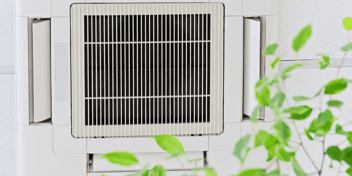4 Min Read
Importance of Indoor Air Quality in Your Custom Home in Houston
.png?width=750&name=Copy%20of%20SGB%20Featured%20Images%20(1).png)
It’s well known these days the importance of indoor air quality (IAQ). What’s not as well known? Indoor air is typically two to five times more contaminated than outdoor air. Mold, off-gassing, VOCs, and other issues with indoor air can affect you and your family’s health. This is why working with your designer to create a luxury home with features and finishes that will have as little impact on your indoor air as possible is so important.
What Are the Sources of Poor Indoor Air Quality?
One of the main sources of indoor air pollution is fine particulate matter, which are microscopic airborne particles. Because of its size, this fine matter not only gets inhaled but can then travel to other parts of the body.
The most common indoor air contaminants:
- Mold and mildew
- Gasses and volatile organic compounds (VOCs)
- Building materials and furnishings
- Fuel-burning appliances, like the kitchen range
- Outdoor pollutants that enter your home
How Does Indoor Air Quality Affect Our health?
Poor IAQ can have short-term and long-term effects. For example, if you or anyone in your family has asthma, it could become worse. You could also develop headaches, skin irritation, or dizziness. Long-term effects are direr, so doing what you can to keep your IAQ as safe as possible during the design phase is very important for your family to live happily and healthily.
What Are the Top 7 Things Your Designer Can Do to Support Indoor Air Quality in Your Custom Home?
Today’s designers and builders are more knowledgeable than ever about designing and creating homes that will make you and your family’s day-to-day healthier. There are materials, finishes, and methods that professionals can use to improve the quality of air in your home. Let your designer or builder know that your focus is to create a healthier home and they can guide you through the process of choosing materials, appliances, and more.
1. Electric Appliances
Designers that are certified designers and scientists alike will tell you that your gas appliances are polluting your indoor air. Of course, a commercial-grade gas range is very tempting to invest in, but if indoor air quality is your priority, opt for electric. Your other appliances that are possibly powered by natural gas are the water heater, clothes dryer, and furnace.
With newer generations of appliances that run on electricity and are built to be incredibly energy efficient, installing Energy Star certified appliances over gas appliances will have plenty of other additional benefits.
2. Choose Low or Zero VOC Paints
As you peruse paint swatches for their hues and tones, consider what they’re made of as well. Paint has traditionally contained volatile organic compounds (VOCs) that contain carbon which become gasses that then become part of your indoor air–a process called off-gassing.
Off-gassing doesn’t only occur while the paint is drying, but for years. VOCs have been used to make the paint dry faster and last longer. Fortunately, companies are improving Low or Zero VOC paints year after year. Big paint brands are also participating, so Low and Zero VOC paints are easy to come by.
3. Low or Zero VOC Flooring
That’s right, VOCs are also found in flooring. Really, VOCs are mostly found in the adhesives used during installation but also in some types of flooring materials. Hardwood flooring is best for indoor air quality, especially when finished with water-based polyurethane.
For a more durable choice, luxury vinyl flooring with Low VOC options is your next best bet and can be made to look just like real wood. It’s also mold resistant. Your third best option for healthier flooring is porcelain or ceramic tiles. These materials contain no VOCs but you’ll need to ask your designer or builder about using Low VOC adhesives to install them.
Avoid carpet. Carpets tend to trap pollutants and cycle them into the air. Frequent deep cleaning can combat this, but it’s best to use wool rugs that are more easily changed out after a couple of years. You will still need to have these deep cleaned, however.
4. In-Duct Air Purifier
An in-duct air purifier works to better allow harmful microparticles to be trapped by air filters and reduces contaminants in your indoor air. Dander, smoke, dust mites, and mold that circulate through your home’s HVAC system will be removed, making your indoor air cleaner. If you’re preparing to remodel, have a certified inspector test your air quality to determine what type of air purification you’ll need.
Having an in-duct air purifier while your custom home is being built is more practical than paying for the installation down the line. Talk to your home builder about the most trusted companies and how to choose the best one for the square footage of your custom home.
5. An Airtight Building Envelope
Your home’s envelope is every outside-facing element that controls or prevents the passage of air and moisture. Windows, roofs, foundation, flashing, and walls all provide protection from outdoor contaminants that could affect your indoor air quality. Proper insulation, high-efficiency windows, and effective sealing will contribute to a tight envelope.
Loose envelopes, on the other hand, let in moisture, which can cause mold and mildew to grow indoors, contaminating your indoor air.
6. Make Room for Plants
Indoor plants can be a powerful and natural way to improve the air quality in your home. Indoor plants work to ‘scrub’ the air of VOCs, absorb carbon dioxide, and filter out a few other of the worst indoor air contaminants. Having only one plant in a room won’t be very effective, if at all, but several will.
How are your designer and builder involved? Work with them to design rooms that cater to plant life, like window placement and proper floor space. Having your designer work in shelving that’s set within the window casings or strategically placed built-ins that are opposite your windows is a great start.
To avoid your plants actually becoming part of the IAQ problem, be sure to check the containers frequently for mold and always use impermeable saucers to avoid moisture transfer to your floors and surfaces.
7. Natural Light
Filling your home with natural light is an easy–and beautiful–way to kill bacteria and improve air quality. The great news is that even when you use energy-efficient windows that are coated to block UV rays, the natural light that is allowed through still does the job. Work with your architect or designer to incorporate expansive windows where possible and skylights in the bathrooms.
Building a Healthy Home in Houston
Commit to prioritizing air quality when it comes to the design, materials, and finishes in your custom luxury home in Houston. By working with your designer and home-building team, your family will breathe cleaner, clearer air all day every day.
Southern Green Builders is a Houston area custom home builder and remodeler that values your family’s health and happiness. Our core values are anchored by the quality of your experience during the process and your quality of life in your new home. Contact Southern Green Builders to schedule a consultation.



